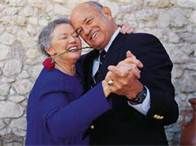
According to research, it does! Studies indicate that ballroom dancing and other stimulating activities may lower the risk of cognitive decline. More importantly, they greatly enhance quality of life, which is something that dementia steals from Alzheimer’s patients and their families. Alzheimer’s Disease International (ADI) reports that 35.6 million people worldwide have some type of dementia. This number is expected to triple by 2050. Alzheimer’s disease (AD), a debilitating brain disease, is the most common form of dementia. Not only does it cause memory problems, but it also affects thinking, behavior and personality. While the risk of Alzheimer’s disease increases with age, it is not “old timer’s disease” or “old age senility” as some people call it. It is not a normal part of aging at all, and it can affect people as young as their 30s and 40s. AD robs people of their whole essence, ravishing both the mind and body. The degenerative disease is a terminal illness with no cure.
Can this dreaded disease be prevented?
This question is one that intrigues doctors, scientists and researchers, and there are no clear-cut answers. The Alzheimer’s Association and other groups continue to fund research on the development and progress of dementia. This is where ballroom dancing and other leisure activities come in. Recent studies are encouraging. Ballroom dance, piano playing, crossword puzzles and other activities appear to keep Alzheimer’s disease at bay. Two well-known studies — the Bronx Aging Study and the Religious Orders Study — suggest that mind-challenging activities may prevent or delay the onset of dementia in older adults.
Does physical activity have the same effect as mental exercise on the development of Alzheimer’s disease?
It really depends on the activity. According to the research, ballroom dancing seems to be one of the few physical activities that can delay the onset of dementia and actually re-wires the cerebal cortex. In addition to physical exercise, ballroom dancing is a cognitive activity that requires concentration. “Ballroom dancing involves precise physical activity, listening to the music, remembering dance steps, and taking your partner into account, which is very mentally testing,” In fact, ballroom dancing is more effective than working crossword puzzles for preventing dementia. The mental challenge of dancing requires a person to think harder. Unlike the effects of purely physical activity, hard thinking will not wear out the brain. In fact, the more people use their “brain muscles,” the sharper they get. Dr. Jacqueline C. Dominguez, Memory Center director at St. Luke’s Medical Center in the Philippines, states that Ballroom dancing is an easy and inexpensive way to combat dementia. “Ballroom dancing has everything in it for people to keep their wits. There can be cardiovascular benefits of many different physical activities for seniors but the only physical activity to actually offer protection against dementia was ballroom dancing on a regular basis.
Reading – 35% reduced risk of dementia
Bicycling and swimming – 0%
Doing crossword puzzles at least four days a week – 47%
Playing golf – 0%
Dancing frequently – 76%. – That was the greatest risk reduction of any activity studied, cognitive or physical.
Quoting Dr. Joseph Coyle, a Harvard Medical School psychiatrist who wrote an accompanying commentary: “The cerebral cortex and hippocampus, which are critical to these activities, are remarkably plastic, and they rewire themselves based upon their use.” Persons seem to be more resistant to the effects of dementia as a result of having greater cognitive reserve and increased complexity of neuronal synapses. Like education, participation in some certain activities lowers the risk of dementia by improving cognitive reserve. Our brain constantly rewires its neural pathways, as needed. If it doesn’t need to, then it won’t. A study done by The Albert Einstein College of Medicine also showed that we need to keep as many of those paths active as we can, while also generating new paths, to maintain the complexity of our neuronal synapses.
But does any kind of dancing lead to increased mental acuity?
No, not all forms of dancing will produce this benefit. Not dancing which, like golf or swimming, mostly works on style or retracing the same memorized paths. The key is the decision-making. Intelligence is what we use when we don’t already know what to do. But when it comes to preserving mental acuity, then some forms are significantly better than others. When we talk of intelligence (use it or lose it) then the more decision-making we can bring into our dancing, the better. “Rapid-fire” decision making is what leads to this improvement in intelligence. Ballroom dancing requires a lot of quick decision making, in both the leading and the following roles. Ballroom dancing integrates the mind, the emotions and the physical which the studies suggest work together to improve mental health. It’s never too early or too late to start strengthening your mind. In conclusion, to help stimulate the mind and the soul, we recommend taking some ballroom dancing lessons if you haven’t already!
References:
1. http://annettersmith.hubpages.com/hub/ballroom-dancing-and-alzheimers-disease
2. http://socialdance.stanford.edu/syllabi/smarter.htm
